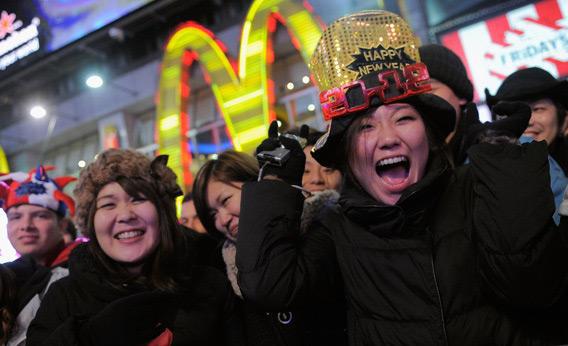This Monday, many Americans will head to church for Christmas Eve services, and next Monday, even more Americans will carouse, clink glasses, and count down to midnight on New Year’s Eve. Yet there are no similar rituals associated with the day before Valentine’s Day, St. Patrick’s Day, or Easter, for instance. Why do we celebrate Christmas Eve and New Year’s Eve but not other holidays’ eves?
We celebrate Christmas Eve because Jesus is traditionally thought to have been born at midnight, and we celebrate New Year’s Eve because midnight is when the year changes. It’s also likely that different historical conceptions of time contributed to the development of eve traditions: In ancient Greece, each old day ended—and each new day began—at sunset. This tradition persists in the Hebrew calendar, and it likely affected the early Christian calendar, too.
Though it’s never explicitly stated in the Bible that Jesus was born at midnight, at least one passage in Wisdom 18 hints at it, saying that the birth occurred when “the night in its swift course was half spent.” Based on this hint, “Christ’s mass”—the phrase from which we get the word “Christmas”—was first celebrated the midnight preceding Christmas Day in the year 380. That year, Christmas was celebrated on Jan. 6, but as the date of Christmas got ironed out, the tradition of a midnight mass preceding the day’s celebration continued and was later adopted by other Christian denominations. Christmas has become increasingly secularized since the 19th century, but Christmas Eve has remained an important part of Christmas celebrations because of the popularization of Santa Claus, who demands preparations like hanging stockings and setting out cookies on Christmas Eve.
People have long celebrated New Year’s Day, though its location on the calendar has moved around quite a bit throughout Western history. The Julian calendar considered Jan. 1 the first day of the new year, but in Medieval Europe, dates with more religious significance (like Dec. 25, Mar. 25—the traditional date of the Annunciation—and Easter) were marked as New Year’s Day, until Europe gradually made the switch to the Gregorian calendar in the 16th, 17th, and 18th centuries. Historically, people have always celebrated the arrival of the new year, though depending on their community’s conception of when days begin, they might begin the celebration at sundown or at sunrise instead of at midnight. In the 18th and 19th centuries, Western Europeans and Americans began marking the midnight between Dec. 31 and Jan. 1 by drinking, ringing bells, or shooting off canons or fireworks—but each community kept its own time, so one town’s midnight might not align with the neighboring town’s midnight. When standard time was adopted at the International Meridian Conference in 1884, midnight became the official dividing line between days worldwide. Now, people could figure out the official time via telegraph, and counting down to midnight on New Year’s Eve became well established as a New Year’s Eve tradition not only in America and Europe but worldwide.
Other Christian and pagan holidays historically included celebrations that began the day before, and some European countries still celebrate other eves. (These holidays and their eves never took root in America because early American settlers were conservative Protestant separatists who wanted to distance themselves from the pomp and jollity of Catholic and Anglican holidays.) Typically, eves are celebrated on holidays that include some supernatural component that occurs only at night (like Santa’s visit) or that mark some important temporal boundary (like midnight on New Year’s). English villagers used to believe that on April 24, St. Mark’s Eve (the day before St. Mark’s feast day), if they stayed on their porches from 11 p.m. to 1 a.m., they’d see images of the people they knew who would die in the coming year. For example, on the day before May Day, known in German as Walpurgisnacht, Central European tradition holds that witches hold a special conference, so people sometimes mark it with a symbolic burning of witch effigies. St. John’s Eve, or Midsummer’s Eve—the shortest night of the year—is still celebrated with bonfires in late June in Western Europe, especially Scandinavia.
Halloween, whose name is a corruption of All Hallow’s Eve, is a unique case. All Hallow’s Eve was adopted by the Catholic Church as a way of incorporating the Gaelic harvest festival of Samhain into All Saint’s Day. (The Celts, like the ancient Greeks, thought of sundown as the beginning of each new day, so they began celebrations of Samhain at night on Oct. 31 and continued the holiday on Nov. 1.) All Saint’s Day used to be celebrated by Catholics as an eight-day commemoration of the dead, but the Catholic Church began downplaying the importance of the holiday in the 1950s, scaling it back to a single day, Nov. 1, which is still commemorated in many Catholic countries. However, Halloween independently became a secularized holiday in America in the 19th century, and recently American-style Halloween has caught on in Western Europe. That means that some Europeans celebrate Halloween and All Saint’s Day as two distinct but consecutive holidays—one secular, one religious—rather than as two closely related holidays, the way we consider Christmas Eve and Christmas.
Got a question about today’s news? Ask the Explainer.
Explainer thanks Christopher Bellitto of Kean University; Roger Ekirch of Virginia Tech, the author of At Day’s Close: Night in Times Past; Bruce Forbes of Morningside College, the author of Christmas: A Candid History; Alexis McCrossen of Southern Methodist University, the author of Marking Modern Times: A History of Clocks, Watches, and Other Timekeepers in American Life; Lisa Morton, the author of Trick or Treat: A History of Halloween; Eviatar Zerubavel of Rutgers University, the author of Hidden Rhythms: Schedules and Calendars in Social Life.
